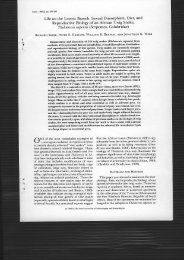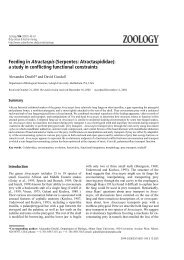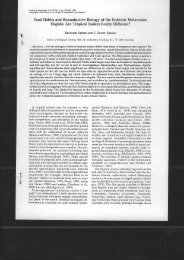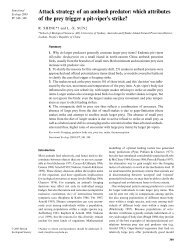Snake bite in Australia: first aid and envenomation ... - Kingsnake.com
Snake bite in Australia: first aid and envenomation ... - Kingsnake.com
Snake bite in Australia: first aid and envenomation ... - Kingsnake.com
You also want an ePaper? Increase the reach of your titles
YUMPU automatically turns print PDFs into web optimized ePapers that Google loves.
<strong>Snake</strong> <strong>bite</strong> <strong>in</strong> <strong>Australia</strong><br />
suitable for apply<strong>in</strong>g adequate <strong>com</strong>pression.<br />
The b<strong>and</strong>age is not to act as a tourniquet,<br />
<strong>and</strong> should be applied to a firmness<br />
appropriate for a spra<strong>in</strong>ed ankle, <strong>and</strong> should<br />
be selected with the size of the limb taken<br />
<strong>in</strong>to consideration, for example a 10 cm<br />
b<strong>and</strong>age is appropriate for the lower limb of<br />
an adult.<br />
3. Do not wash or clean the site prior to<br />
application, as this will remove traces of<br />
venom required for snake <strong>and</strong> antivenom<br />
identification. A small w<strong>in</strong>dow can be cut <strong>in</strong><br />
the b<strong>and</strong>age at the <strong>bite</strong> site to take a venom<br />
swab. A mark on the outside of the b<strong>and</strong>age,<br />
placed at the time of application, can assist<br />
<strong>in</strong> identify<strong>in</strong>g the appropriate site for the<br />
w<strong>in</strong>dow.<br />
4. A spl<strong>in</strong>t should be applied to keep the limb<br />
immobilised, <strong>and</strong> the patient placed <strong>in</strong> a<br />
position of rest.<br />
5. This b<strong>and</strong>age should rema<strong>in</strong> <strong>in</strong> place until<br />
the possibility of <strong>envenomation</strong> has been<br />
excluded, or an <strong>in</strong>fusion of antivenom has<br />
been <strong>com</strong>menced<br />
Identify<strong>in</strong>g the snake <strong>in</strong>volved<br />
It is necessary to identify if a snake<strong>bite</strong> has<br />
occurred, <strong>and</strong> as a separate responsibility,<br />
identify if <strong>envenomation</strong> of the victim has<br />
occurred. Fang marks are not always left after a<br />
snake has bitten. There may be a scratch, or it<br />
may not be possible to identify any marks at all<br />
(AVRU 2000). In this case it is necessary to rely<br />
on the patients description of where the <strong>bite</strong><br />
occurred. It is important to realise that this<br />
does not exclude the possibility of snake<strong>bite</strong>,<br />
<strong>and</strong> assessment <strong>and</strong> management of<br />
<strong>envenomation</strong> needs to cont<strong>in</strong>ue.<br />
Even if a snake does <strong>bite</strong>, it does not always<br />
<strong>in</strong>ject venom, adequate venom to cause<br />
<strong>envenomation</strong>, or <strong>in</strong>ject venom <strong>in</strong>to the tissues<br />
(AVRU 2000). A Venom Detection Kit (VDK),<br />
developed by the Commonwealth Serum<br />
Laboratories under the guidance of the late<br />
Struan Sutherl<strong>and</strong>, is used to identify the type<br />
of snake, <strong>and</strong> the antivenom to be used <strong>in</strong> the<br />
case of <strong>envenomation</strong>. This test is considered<br />
highly reliable (White 1998). The VDK is more<br />
reliable than visual identification of the snake,<br />
as snake appearance alters with seasonal<br />
changes. Much identification is based on scale<br />
shape <strong>and</strong> size rather than overall colour <strong>and</strong><br />
mark<strong>in</strong>gs <strong>and</strong> requires an experienced<br />
herpetologist to dist<strong>in</strong>guish one type of snake<br />
from another (AVRU 2000). Visual<br />
identification of the snake often requires the<br />
snake to be killed, <strong>and</strong> this practice <strong>in</strong>creases<br />
the danger <strong>and</strong> probability of snake <strong>bite</strong>,<br />
angers the snake <strong>and</strong> <strong>in</strong>creases the danger of<br />
<strong>envenomation</strong>, <strong>and</strong> is an illegal act as snakes <strong>in</strong><br />
<strong>Australia</strong> are a protected species under the<br />
Nature Conservation Act 1980 (Environment<br />
ACT 2000).<br />
Swabs of the site, <strong>and</strong> if systemic symptoms<br />
are present, ur<strong>in</strong>e, is <strong>com</strong>b<strong>in</strong>ed with the<br />
solutions <strong>and</strong> vials as directed by written<br />
<strong>in</strong>structions supplied with the VDK. The<br />
results will <strong>in</strong>form cl<strong>in</strong>icians of the type of<br />
antivenom that will be effective. Blood is not<br />
re<strong>com</strong>mended for use <strong>in</strong> the VDK as it can give<br />
mislead<strong>in</strong>g results <strong>in</strong> the form of false positives<br />
<strong>and</strong> false negatives (Sprivulis & Jel<strong>in</strong>ek 2000;<br />
White 1998).<br />
Identify<strong>in</strong>g <strong>envenomation</strong><br />
If venom has been identified through the VDK,<br />
it is then necessary to determ<strong>in</strong>e if the patient<br />
has been envenomated. Many patients,<br />
although certa<strong>in</strong>ly bitten by a snake do not<br />
experience <strong>envenomation</strong> (Sprivulis & Jel<strong>in</strong>ek<br />
2000). This will possibly have already been<br />
determ<strong>in</strong>ed by the frequent assessment that<br />
will have been cont<strong>in</strong>u<strong>in</strong>g throughout the<br />
venom identification process. Victims should<br />
be observed for signs of paralysis or<br />
paraesthesia, such as blurred vision, slurred<br />
speech. These are symptoms associated<br />
with the neurotox<strong>in</strong>s found <strong>in</strong> many of<br />
<strong>Australia</strong>’s snakes, but may also be due to<br />
myotox<strong>in</strong> activity (White 1998). Other tests<br />
<strong>in</strong>clude a full blood exam<strong>in</strong>ation <strong>and</strong> clott<strong>in</strong>g<br />
profile to identify abnormalities associated<br />
with haemotox<strong>in</strong>s. Physical assessment may<br />
reveal bruis<strong>in</strong>g or ooz<strong>in</strong>g of blood from<br />
small wounds or mucous membranes (White<br />
1998). Urea, creat<strong>in</strong><strong>in</strong>e, electrolytes, <strong>and</strong><br />
creat<strong>in</strong><strong>in</strong>e k<strong>in</strong>ase should also be evaluated<br />
for signs of effects of tox<strong>in</strong>s on renal function<br />
<strong>and</strong> muscle breakdown. Any variation from<br />
normal identified <strong>in</strong> frequent assessments<br />
should be considered as a sign of<br />
<strong>envenomation</strong>.<br />
ª 2003 Elsevier Science Ltd. All rights reserved. Accident <strong>and</strong> Emergency Nurs<strong>in</strong>g (2003) 11, 106–111 109










